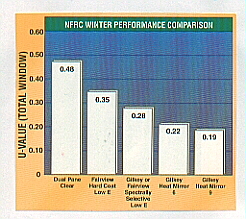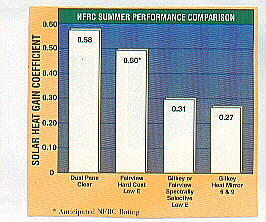Windows and doors are the largest sources of heat gain and heat loss in an average home. High quality and high performance windows will absolutely save you money over the life of a home. If you are building a new home, it makes great sense to buy the best windows you can possibly afford. Economize on things that are easy to change out like carpeting and vanity faucets!
Common Complaints
One of the most common complaints I get about windows is seals that have failed. You know, the window gets a fog in it or is hazy.
Older style insulated windows used aluminum spacers to create the dead air space between the pieces of glass. Aluminum is corrosion resistant, however it readily conducts cold (and heat). Windows with old style aluminum spacers in a cold climate can lower the edge temperatures of the inner piece of glass dramatically. There have been some recent improvements in insulated glass spacing technology. This new warm edge technology uses different spacer materials that do not readily conduct heat or cold. Be sure to ask what type of spacers are in your windows.
The seals that are between the pieces of insulated glass have had a history of failing. This causes the inner surfaces between the two pieces of glass to fog up. Constant improvements in seal technology and the types of spacer materials have minimized seal failure in recent years, but it is still a possibility no matter what type of glass is in your vinyl windows. Be sure to ask about the warranty with respect to failed glass seals when you are talking to salespeople.
Condensation Problems
Water vapor that collects on a cool surface is called condensation. It can start out as a light fog but builds up to beads of water that run down a pane of glass. Condensation on windows happens when the temperature of the glass equals or drops below the dew point of the air that is in contact with the glass. As the humidity inside a house rises, the dew point generally goes up as well since the warm, expanding air can hold more water vapor.
You can minimize condensation on new windows by purchasing glass that has the lowest U-value (low U-values mean a greater resistance to heat loss or heat gain) and has the best warm edge spacing technology available. Soft coat Low-E glass or those windows that have the invisible Low-E films tend to have the lowest U-values. These windows allow the inner piece of glass to stay as warm as possible. Imagine a cold night with an outside temperature of 0 degrees and a 15 mph wind while it is 72 degrees inside your home. A single pane of glass will register an inner surface temperature of 26 degrees. Regular double pane glass will be 35 degrees. Hard coat insulated Low-E glass will usually be 49 degrees, while soft coat insulated Low-E glass will be a comfortable 62 degrees. The warmer the inner piece of glass in your house the less chance condensation will form. Warmer inner glass surfaces create fewer cold convection currents or drafts.
Condensation can happen when you get new windows. Why? Because the installation of the new windows actually cuts down drastically on air infiltration. Before your new windows were installed, cold dry air could easily mix with the warm moist air inside your house. This effectively lowers the humidity inside your home. Once new windows are installed, indoor humidity levels tend to rise as does the dew point! This means that condensation can start to form on new glass surfaces that are actually warmer than before. You can reduce condensation on your vinyl windows by lowering the overall humidity level inside your home.
Custom Glass
Possibly the best window glass available today contains the invisible heat film that is suspended between the panes of glass. This glass has all sorts of advantages over regular insulated glass.
For starters, it is more comfortable. The heat film stops intense solar radiation and heat from entering your home during the summer months. During cold winter weather, the inside air temperature is warmer because cold convection currents are minimal. Keep in mind that the warmer the surface of the glass is, the warmer you will feel inside. Heat film glass produces the highest indoor glass temperatures.
Heat film glass is also very effective at stopping noise. Some glass systems can reduce noise by as much as 56 percent compared to standard insulating glass. I have witnessed this myself. The noise reduction is significant. It is even more so if all air leaks around the window frame are plugged.
The heat film that is offered by some window companies actually can be customized. In other words, the heat film comes in different insulating and solar control performance levels. For example, you may chose one type for all windows that face south and another specialty film for all windows that face north. Ask your window company about this very cool option.
Broken Glass - It Can Happen!
The manner in which the glass is installed in your vinyl window sash is important. Old wood, steel and aluminum windows allow you to replace broken glass with some effort. This is not always the case with vinyl windows. Some vinyl windows are built in such a way that when and if glass breaks you must replace the entire sash. This can be a disadvantage if for some reason the vinyl itself has changed colors due to poor quality materials or years of exposure to sunlight. The new replacement sash color may not match your existing frame.
Consider purchasing vinyl windows that can be re-glazed without having to buy a new sash. These will give you much greater flexibility.
Warranties
Lifetime warranties are available. Look for these and make sure the company has been in business for 15 to 20 years. Any startup company can offer a lifetime warranty. You are looking for a company with a track record.
Column B291

